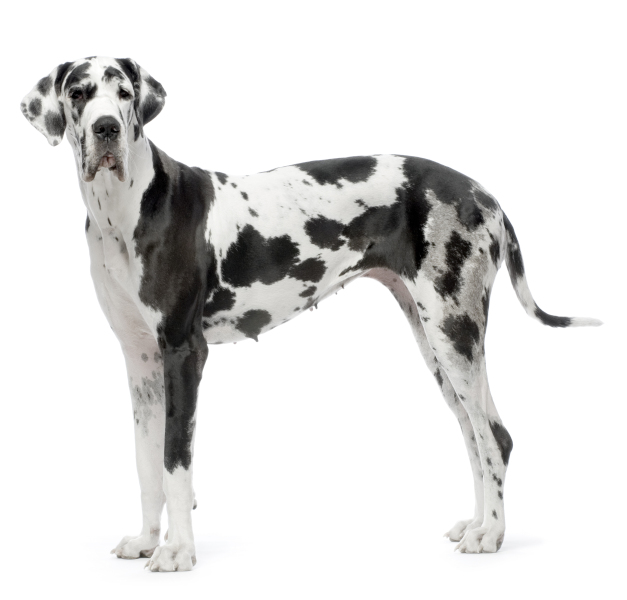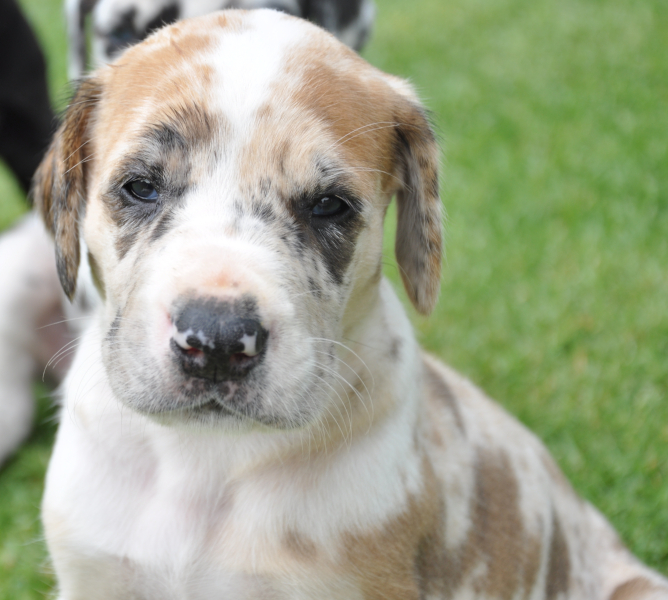Quick Summary

Click here for Price and Turnaround Time
Phenotype: Harlequin Great Danes display a pattern of irregular dark patches on a white background. The show standard, officially recognized Harlequin pattern is black and/or gray patches on a white background, but patches may also be dilute blue ("blue harlequin" or "bluequin"), brindle ("brindlequin"), or sable ("fawnequin").
Mode of Inheritance: Autosomal dominant
Alleles: N = Normal (non-Harlequin), H = Harlequin
Breeds appropriate for testing: Great Dane
Explanation of Results:
- Dogs with N/N genotype will not display Harlequin patterning; they lack this Harlequin variant. They cannot pass this Harlequin variant to any of their offspring.
- Dogs with N/H genotype are expected to express the Harlequin coat pattern if they also possess the Merle gene and produce black pigment. They may transmit this Harlequin variant to 50% of their offspring. Breedings between two N/H genotype dogs are expected to result in 25% embryonic lethal offspring.
- Dogs with H/H genotype are expected to terminate in utero (embryonic lethal genotype).
Results of this test can be submitted to the OFA (Orthopedic Foundation for Animals)
Dog Coat Color - Great Dane Panel
$80 per animal
Additional coat colors $15 per test
Sample Collection
Dog DNA tests are carried out using cells brushed from your dog's cheeks and gums. The preferred cytology brushes are sent to you by mail, or you may provide your own brushes. For accepted alternative brushes, click here
We recommend waiting until puppies are at least three weeks old before testing.

Step-By-Step:
- Make sure the dog has not had anything to eat or drink for at least 1 hour prior to collecting sample.
- When swabbing puppies, isolate each puppy from the mother, littermates and any shared toys for 1 hour prior to swabbing. Puppies should not have nursed or eaten for 1 hour prior to collecting sample.
- If collecting samples from more than one dog, make sure to sample one dog at a time and wash your hands before swabbing another dog.
- Label brush sleeve with name or ID of dog to be sampled.
- Open brush sleeve by arrow and remove one brush by its handle.
- Place bristle head between the dog’s gums and cheek and press lightly on the outside of the cheek while rubbing or rotating the brush back and forth for 15 seconds.
- Wave the brush in the air for 20 seconds to air dry.
- Insert brush back into sleeve.
- Repeat steps 5 - 8 for each unused brush in sleeve on a fresh area of cheek and gums. Make sure to use and return all brushes sent by the VGL. In most cases, it will be 3 brushes per dog. If using interdental gum brushes, please note that the VGL requires 4 brushes per dog and only moderate or wide interdental gum brushes are accepted.
- Do not seal brushes in sleeve.
- Place all samples in an envelope and return to the address provided.
ATTENTION:
- Do not collect saliva/drool – the key to obtaining a good sample is getting cheek cells on the swab
- Do not rub swab on the dog’s tongue or teeth – this will result in poor quality sample
- Do not collect a sample from a puppy that has recently nursed – the mother’s genetic material can rub off on the puppy’s mouth and contaminate the sample

The interaction of many genes is involved in the variety of colors and patterns of dog coat color. Harlequin is a pattern seen in Great Danes resulting from the complex interaction of the Merle (PMEL17) and Harlequin (PSMB7) genes on black pigment. The dominant Merle gene by itself produces dark spots on a dilute background on eumelanistic dogs. If a merle dog also inherits 1 copy of the Harlequin gene, the dark spots increase in size and the background pigment is removed altogether. Dogs that are not merle, or only have red pigment, cannot express the Harlequin gene. Two copies of Harlequin have not been observed and is presumed to be embryonic lethal, thus all Harlequin patterned dogs have only 1 copy of the mutation.
